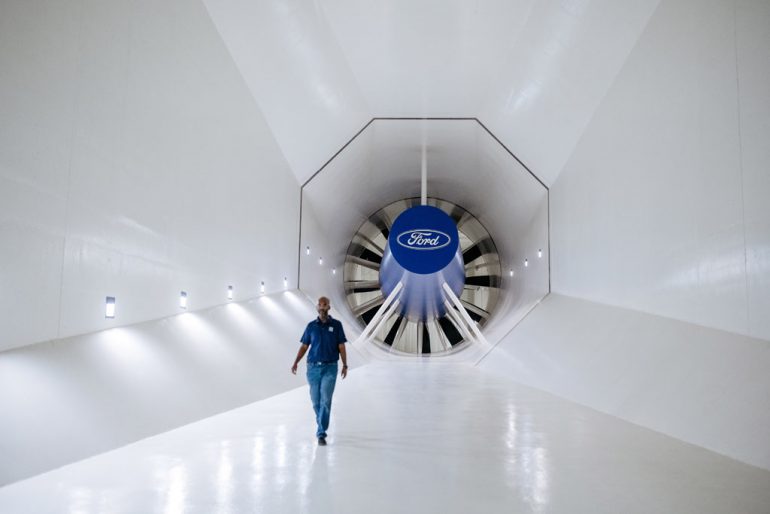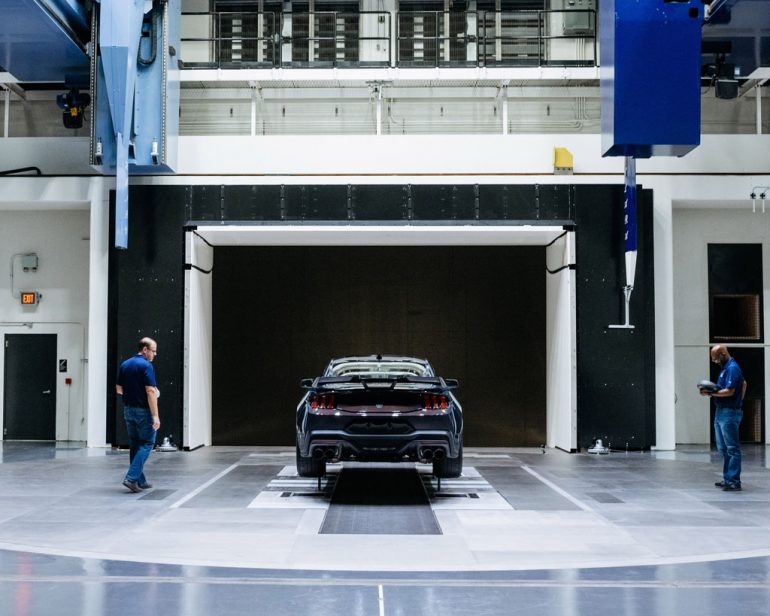
Ford has developed an innovative approach to testing vehicle aerodynamics with the introduction of a rolling road wind tunnel. This cutting-edge technology allows Ford engineers to simulate speeds of up to 200 mph, providing valuable data for vehicle development. This facility played a crucial role in the creation of the 2024 Mustang Dark Horse, a track-focused Mustang model set to hit the market this summer.
By incorporating a rolling surface into the wind tunnel, Ford’s engineers were able to replicate realistic wheel speeds during testing. This setup utilizes individual belts for each wheel, similar to a treadmill, although a single large belt can also be used. This dynamic configuration allows the wheels of the test vehicle to rotate as they would on the road, providing more accurate drag and downforce measurements. This becomes particularly significant when assessing the aerodynamic impact of various wheel patterns.

John Toth, Ford’s North America Wind Tunnels Engineering Supervisor, emphasized the importance of this technology for enhancing aerodynamics in high-performance vehicles like the Mustang Dark Horse. These vehicles require a delicate balance between aerodynamic drag and downforce to optimize their track performance. By enabling testing while the wheels and tires are in motion, Ford can refine the aerodynamic characteristics of their vehicles, delivering superior handling and stability.

The benefits of the rolling road wind tunnel extend beyond high-performance cars. This technology also plays a crucial role in the development of regular vehicles, particularly electric vehicles (EVs). In the pursuit of efficiency and extended range, low drag is essential for EVs. The rolling road wind tunnel helps engineers analyze aeroacoustics, focusing on reducing wind noise, which becomes more noticeable with the absence of the internal combustion engine and exhaust system.

Furthermore, this advanced testing facility enables extensive testing that was previously conducted on open roads to be brought indoors, reducing costs and saving vehicle development time. The ability to perform a wide range of tests within the controlled laboratory environment allows for more efficient and thorough vehicle evaluations.

Ford’s rolling road wind tunnel represents a significant advancement in automotive testing and development. By incorporating realistic wheel speeds into aerodynamic assessments, engineers can optimize vehicle performance and efficiency. This technology not only benefits high-performance vehicles that rely on downforce but also contributes to the development of quieter and more aerodynamically efficient EVs. With its ability to save costs and accelerate vehicle development, the rolling road wind tunnel is a game-changer for the automotive industry.


Lloyd Tobias is a seasoned automotive journalist and passionate enthusiast with over 15 years of experience immersed in the world of cars. Whether it’s exploring the latest advancements in automotive technology or keeping a close pulse on breaking industry news, Lloyd brings a sharp perspective and a deep appreciation for all things automotive. His writing blends technical insight with real-world enthusiasm, making his contributions both informative and engaging for readers who share his love for the drive. When he’s not behind the keyboard or under the hood, Lloyd enjoys test driving the newest models and staying ahead of the curve in an ever-evolving automotive landscape.